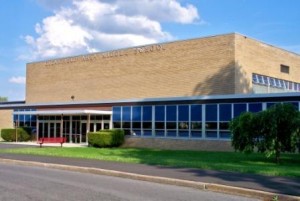
CLEARFIELD – Resident Gail Ralston confronted the Clearfield Area School District Board of Directors Monday night with Clearfield Middle School reading scores and sought answers about why the district hasn’t addressed its library plan, which currently has the middle school students sharing a librarian with the Clearfield Area High School.
Ralston began her presentation by reading a series of four quotes that Superintendent Dr. Thomas B. Otto provided for an article that published in The Progress in October of 2011. She said the quotes showed his commitment to reading and education.
She said the district assessed 1,217 students in grades three through eight and eleven in reading during the 2011-12 Pennsylvania System of School Assessment exams. Of those, she said 69 percent scored proficient and above, while the economically disadvantaged student subgroup scored 60 percent proficient or above, according to a previous GantDaily.com report.
In grades five through eight, Ralston pointed out that middle school students scored 67 percent proficient or above in reading. Overall, the economically disadvantaged student subgroup scored 57 percent proficient or above.
Ralston focused on the district’s PSSA reading results for the economically disadvantaged student subgroup in grades three through seven, which she obtained from a previous GantDaily.com report. She said these students are impacted by the construction transition period.
She said the economically disadvantaged student subgroup scored 63 percent and 64 percent proficient or above in the third and fourth grades, respectively. The subgroup scored 44 percent proficient or above in the fifth grade, 48 percent in the sixth grade, 59 percent in the seventh grade and 61 percent in the eighth grade.
Ralston said if board members averaged the figures for the middle school students in grades five through eight, the economically disadvantaged subgroup scored 53.75 percent proficient or above. Further, she said the final middle school class (grades three through six) would have a current score of 54.75 proficient or above.
“I understand that gains will hopefully be made in the interim time, but this is where to start,” she said. She said of the middle school students, 23 percent aren’t reading at a proficient level and more than 45 percent aren’t within the economically disadvantaged subgroup.
“This is not news to you,” said Ralston. “I’m sure you’re working on strategies to deal with it.”
According to her, she believed the current library system asks middle school students to provide an ID number when they check out books. She said it would be informative to compare book usage from former years with the current one. She said administrators should be interested in which students are using the library and its resources.
Ralston said this subgroup should be the one that needs the library services, and perhaps, it might even need it more than any other. She said they should be identified by their “no-use” through the check-out computer program. She said the librarian could help the middle school team integrate and focus on the very students who need to be reading books.
“It’s only two years that our students will not have a librarian. But the questions are: ‘what needs are going to be met?’ and ‘what achievements are going to be limited,’” said Ralston.
She said that according to the high school calendar, the librarian has it filled with integrating library skills with core subject areas and enriching the students’ learning. She said that a certified librarian should be available in every student’s schedule rather than select ones.
Ralston pointed out that when construction begins at the high school library, the librarian will transfer to the middle school. She said this doesn’t solve the problem and merely shifts it from one student group onto another.
“Separate is not equal,” she said. “It’s now the end of October, and two months of opportunities have passed. I know that both the board and its administrators have multiple tasks that require your time and attention.
“But personally, I can’t understand how an item as important as the library and our students’ needs is not at the forefront. Time spent on an extracurricular problem should not have had precedence over academic/student achievement.”
Ralston said she realizes the district’s finances are limited, but this subject is the students’ education.